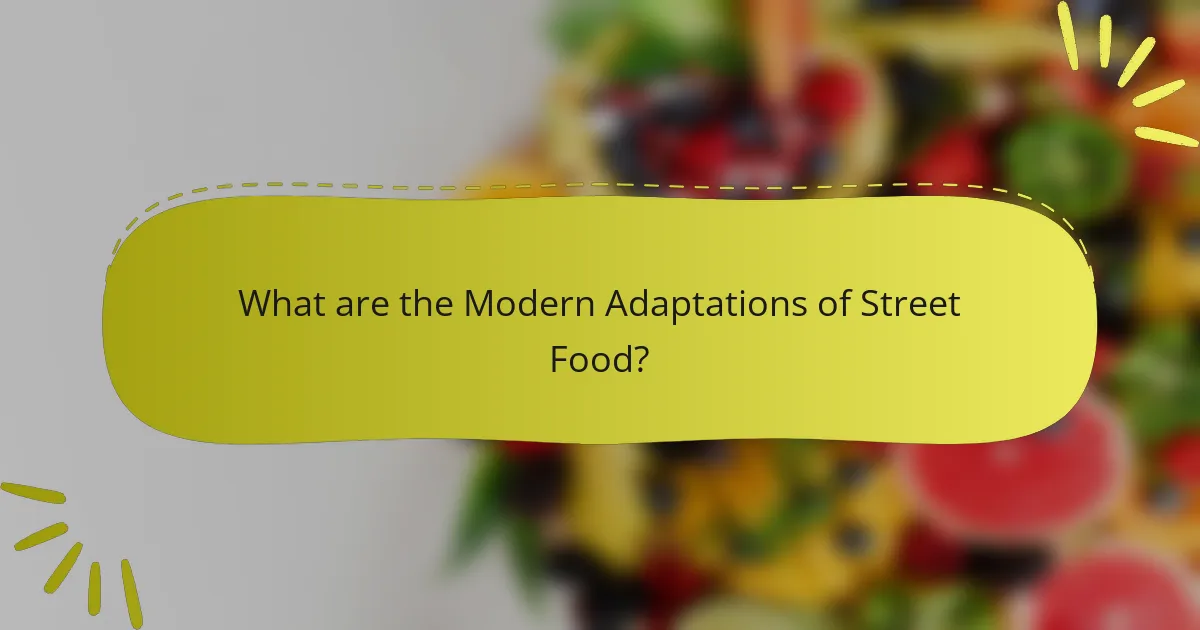Street food, a vital aspect of culinary culture, has undergone significant evolution from its origins in ancient civilizations to contemporary global trends. This article explores the historical context of street food, highlighting its roots in urban centers like ancient Rome and its growth during the 19th-century industrialization. Modern adaptations, including gourmet food trucks and fusion cuisine, showcase a blend of traditional and innovative culinary practices. The article also examines the economic impact of street food on local economies and tourism, as well as its role in promoting cultural exchange and community interaction. The influence of social media on the visibility and popularity of street food is also addressed, illustrating its importance in today’s food landscape.

What is the Evolution of Street Food?
Street food has evolved significantly over centuries. It originated in ancient civilizations, where vendors sold food in public spaces. In ancient Rome, for example, street food was common among the lower classes. The rise of urbanization in the 19th century led to increased street food popularity. Industrial cities saw food carts and stalls catering to workers.
In the 20th century, globalization influenced street food, introducing diverse cuisines. Modern adaptations include gourmet food trucks and fusion dishes. Today, street food is celebrated worldwide for its convenience and cultural significance. According to a 2018 report by the World Street Food Congress, street food contributes to local economies and tourism.
How has street food evolved over time?
Street food has evolved significantly over time, reflecting cultural changes and urbanization. In ancient civilizations, vendors sold food in public spaces, often reflecting local ingredients and traditions. The Middle Ages saw street food expand in Europe, with markets offering ready-to-eat meals for workers. The Industrial Revolution further transformed street food, as cities grew and food became more accessible. In the 20th century, globalization introduced diverse cuisines to urban areas, enhancing variety. Today, street food incorporates modern culinary techniques and fusion flavors, appealing to a global audience. It has become a cultural phenomenon, celebrated for its convenience and authenticity.
What historical factors influenced the development of street food?
Street food developed due to urbanization, migration, and trade. Urbanization led to increased populations in cities, creating a demand for quick, affordable meals. Migration introduced diverse culinary traditions and ingredients, enriching street food offerings. Trade routes facilitated the exchange of spices and cooking techniques, influencing local street food cultures. Historical events, such as wars and economic shifts, also shaped street food practices, as people sought convenient food options during hardships. Additionally, cultural festivals and markets provided platforms for street vendors to showcase their food, further embedding street food in social traditions.
How did cultural exchanges shape street food traditions?
Cultural exchanges significantly shaped street food traditions through the blending of diverse culinary practices. As trade routes expanded, ingredients and cooking techniques traveled across regions. For example, the Silk Road facilitated the introduction of spices from Asia to Europe. This exchange led to new flavors and dishes that became popular in local street food scenes. Immigrant communities also played a crucial role by bringing their traditional recipes to new countries. The fusion of these cuisines created unique street food offerings. Festivals and markets further promoted this culinary diversity, allowing for the sharing of various food traditions. Historical events, such as colonization, also influenced street food by introducing foreign ingredients and cooking styles. Thus, cultural exchanges have been pivotal in evolving street food into a global phenomenon.
What are the key characteristics of street food?
Street food is characterized by its accessibility, affordability, and variety. It is typically sold by vendors in public spaces. Street food is often prepared quickly and on-site, allowing for fresh consumption. The food is usually served in portable containers for convenience. It reflects local culinary traditions and ingredients, showcasing regional flavors. Street food is often associated with social gatherings and cultural experiences. According to the Food and Agriculture Organization, street food contributes significantly to urban food systems. It provides livelihood opportunities for many vendors worldwide.
What types of cuisine are commonly found in street food?
Street food commonly features a variety of cuisines from around the world. Popular types include Asian, Latin American, Middle Eastern, and Mediterranean cuisines. Asian street food often includes dishes like dumplings, satay, and pho. Latin American options frequently consist of tacos, empanadas, and arepas. Middle Eastern street food typically features falafel, shawarma, and kebabs. Mediterranean street food often includes gyros and souvlaki. These cuisines reflect local ingredients and cultural practices. Street food serves as an accessible way for people to experience diverse culinary traditions.
How does street food reflect local culture and identity?
Street food reflects local culture and identity through its ingredients, preparation methods, and serving styles. It often utilizes locally sourced ingredients, showcasing regional agriculture and culinary traditions. For example, tacos in Mexico highlight corn and local spices, while pho in Vietnam emphasizes rice noodles and herbs. Street food vendors frequently represent cultural practices and community gatherings. In many societies, these vendors serve as social hubs where people connect and share experiences. Historical influences shape street food, with recipes evolving from traditional family dishes. Festivals and local events often feature street food, reinforcing cultural identity. Studies show that street food contributes to local economies, preserving culinary heritage. This interplay of food, culture, and community illustrates the significance of street food in expressing local identity.

What are the Modern Adaptations of Street Food?
Modern adaptations of street food include gourmet food trucks and fusion cuisine. These adaptations elevate traditional street food by incorporating high-quality ingredients. Food trucks offer diverse menus, often featuring international flavors. Fusion cuisine blends elements from different culinary traditions, creating unique dishes. For example, Korean tacos combine Korean barbecue with Mexican tortillas. Additionally, health-conscious options have emerged, such as vegan street food. These adaptations cater to evolving consumer preferences. They reflect trends in sustainability and dietary restrictions. Overall, modern street food is a dynamic blend of tradition and innovation.
How has street food adapted to contemporary trends?
Street food has adapted to contemporary trends by incorporating health-conscious options and innovative flavors. Vendors now offer organic, gluten-free, and vegan choices to cater to changing consumer preferences. The use of social media for marketing has transformed how street food is promoted. Food trucks have emerged as mobile dining experiences, enhancing accessibility. Fusion cuisines are increasingly popular, blending traditional recipes with global influences. Sustainability practices are being adopted, with many vendors using eco-friendly packaging. Additionally, gourmet street food has gained traction, elevating the quality of offerings. These adaptations reflect the evolving tastes and values of modern consumers.
What role does technology play in modern street food offerings?
Technology enhances modern street food offerings by improving food preparation, safety, and customer engagement. Mobile apps streamline ordering and payment processes for consumers. Digital payment systems increase convenience and reduce cash handling. Food trucks utilize GPS technology for location tracking, helping customers find them easily. Social media platforms promote street food vendors, expanding their reach and customer base. Additionally, cooking equipment innovations allow for faster and more efficient food preparation. These advancements contribute to the overall growth and popularity of street food in urban areas.
How have dietary preferences influenced street food menus?
Dietary preferences have significantly influenced street food menus by prompting vendors to adapt their offerings to meet consumer demands. As people become more health-conscious, many street food vendors now include healthier options. For example, the rise of vegetarian and vegan diets has led to an increase in plant-based dishes. Additionally, gluten-free options are becoming more common as awareness of gluten intolerance grows.
Cultural dietary restrictions also shape street food offerings. In regions with large populations adhering to specific religious dietary laws, such as halal or kosher, vendors often cater to these needs. The demand for organic ingredients has also emerged, prompting some vendors to source their produce from organic farms.
Research shows that street food markets are increasingly reflecting local dietary trends. A study by the Food and Agriculture Organization highlights that street food plays a crucial role in urban food systems, adapting to the nutritional preferences of the population. Overall, dietary preferences drive innovation and diversity in street food menus, ensuring they remain relevant and appealing to consumers.
What challenges do modern street food vendors face?
Modern street food vendors face numerous challenges that impact their operations. Regulatory compliance is a significant issue. Many vendors struggle to navigate local health and safety regulations. This often leads to fines or business closures. Access to quality ingredients can also be problematic. Vendors may face supply chain disruptions that affect food quality. Competition is fierce in urban areas. This saturation makes it difficult for some vendors to attract customers. Additionally, financial constraints are common. Many street food vendors operate on tight budgets, limiting their ability to invest in equipment or marketing. Weather conditions can pose risks as well. Rain or extreme heat can deter customers and reduce sales. These challenges require vendors to be adaptable and resourceful to succeed.
How do regulatory changes impact street food businesses?
Regulatory changes significantly impact street food businesses by altering operational requirements and compliance costs. New health and safety regulations can necessitate changes in food preparation methods. This may require street vendors to invest in better equipment or facilities. Licensing requirements can also increase operational costs, affecting profit margins. Additionally, zoning laws may restrict where street food vendors can operate. These changes can lead to reduced market access and customer reach. For example, stricter regulations in urban areas can limit vendor locations to designated zones. Consequently, compliance with regulatory changes can determine the sustainability and growth of street food businesses.
What are the economic challenges for street food vendors today?
Street food vendors face several economic challenges today. High competition in urban areas reduces profit margins. Rising food costs impact pricing strategies for vendors. Regulatory fees and licensing requirements add financial burdens. Limited access to funding restricts business expansion opportunities. Health and safety regulations can increase operational costs. Seasonal fluctuations in demand affect revenue stability. Additionally, economic downturns can reduce consumer spending on non-essential food options. These factors collectively hinder the financial viability of street food businesses.

What is the Global Influence of Street Food?
Street food has a significant global influence, shaping culinary traditions and cultural exchanges. It serves as a vital source of income for millions worldwide. In many cities, street food reflects local flavors and ingredients, showcasing regional diversity. This type of food often fosters community and social interaction.
Street food also plays a role in tourism, attracting visitors seeking authentic local experiences. According to a report by the Food and Agriculture Organization, street food contributes to urban economies and food security. Additionally, it promotes innovation as vendors adapt to global food trends.
The rise of social media has further amplified the visibility of street food, creating global food movements. Overall, street food’s influence extends beyond mere sustenance, impacting culture, economy, and social dynamics worldwide.
How does street food contribute to global culinary trends?
Street food contributes to global culinary trends by introducing diverse flavors and cooking techniques. It reflects local cultures and traditions, offering unique dishes that inspire chefs worldwide. Street food often showcases fusion cuisines, blending elements from different cultures. This innovation influences restaurant menus and home cooking styles. For example, taco trucks in the U.S. have popularized Mexican cuisine, leading to a wider acceptance of spicy flavors. Additionally, street food events and festivals promote culinary exchange, allowing chefs to experiment and share their creations. As a result, street food plays a significant role in shaping contemporary food culture globally.
What are some examples of street food that have gained international popularity?
Tacos, sushi, and falafel are examples of street food that have gained international popularity. Tacos originated in Mexico and are now enjoyed worldwide. Sushi, a Japanese dish, has become a global favorite in various forms. Falafel, a Middle Eastern food, is widely consumed in many countries. These street foods have transcended their local origins. They are now staples in numerous international food markets. Their adaptability and flavor contribute to their global appeal.
How do street food festivals promote cultural exchange?
Street food festivals promote cultural exchange by showcasing diverse culinary traditions. They bring together vendors from various cultural backgrounds. Attendees experience authentic dishes from different regions. This exposure fosters appreciation for global cuisines. Participants often engage in conversations about food origins and preparation methods. Such interactions enhance understanding of cultural practices. Festivals also encourage collaborations between local and international chefs. This blending of culinary styles creates innovative dishes that reflect cultural fusion.
What is the future of street food globally?
The future of street food globally is expected to grow significantly. This growth is driven by increasing urbanization and changing consumer preferences. Street food offers convenience and diverse culinary experiences. According to a report by Technavio, the global street food market is projected to grow by over $3 billion from 2021 to 2025. Health-conscious options and gourmet street food are becoming more popular. Additionally, technology is enhancing food delivery services for street vendors. Sustainability practices are also being adopted to reduce waste. Overall, street food is evolving to meet modern demands while retaining its cultural roots.
How are sustainability practices shaping the street food industry?
Sustainability practices are significantly influencing the street food industry by promoting eco-friendly sourcing and waste reduction. Many street food vendors are now prioritizing local and organic ingredients. This shift minimizes carbon footprints associated with transportation. Additionally, the use of biodegradable packaging is becoming more common. Vendors are adopting practices that reduce food waste, such as offering smaller portion sizes. Research indicates that 60% of street food vendors are implementing sustainable practices. This trend attracts environmentally-conscious consumers, enhancing market competitiveness. Overall, sustainability is reshaping the street food landscape towards a more responsible and health-oriented approach.
What innovations can we expect in the street food scene?
Innovations in the street food scene include the integration of technology, sustainability practices, and diverse culinary influences. Mobile apps for ordering and payment streamline the customer experience. Food trucks are incorporating eco-friendly materials and practices. Fusion cuisines are becoming more popular, blending flavors from different cultures. Plant-based options are on the rise, catering to health-conscious consumers. Virtual kitchens are emerging, allowing chefs to operate without a physical storefront. These trends reflect changing consumer preferences and technological advancements in the food industry.
What practical tips can enhance the street food experience?
Choose popular vendors with high customer turnover for fresher food. Look for stalls with long lines; they often indicate quality. Observe food preparation to ensure hygiene and freshness. Ask locals for recommendations; they know the best spots. Sample small portions from multiple vendors to experience variety. Carry hand sanitizer for cleanliness before eating. Use cash for quicker transactions, as many street vendors may not accept cards. Enjoy street food during peak hours for the best selection and freshness.
How can consumers choose safe and high-quality street food?
Consumers can choose safe and high-quality street food by following specific guidelines. First, they should observe the cleanliness of the vendor and the food preparation area. A clean environment indicates attention to hygiene. Second, consumers should check if the vendor uses fresh ingredients. Freshness is key to food quality and safety. Third, they can look for high customer turnover. Busy vendors often indicate good food and safety standards. Fourth, consumers should inquire about food storage practices. Proper storage minimizes the risk of foodborne illnesses. Additionally, they can seek recommendations from locals or trusted sources. Positive reviews often reflect quality and safety. Lastly, consumers should pay attention to food temperature. Hot food is less likely to harbor harmful bacteria. Following these steps helps ensure a safe and enjoyable street food experience.
What are the best practices for street food vendors to thrive?
Street food vendors can thrive by ensuring high food quality and safety. Maintaining cleanliness in food preparation and serving areas is essential. Offering a diverse menu that caters to local tastes attracts more customers. Setting competitive prices encourages repeat business and customer loyalty. Engaging with customers through social media enhances visibility and brand recognition. Understanding local regulations and obtaining necessary permits is crucial for legal operation. Participating in local events increases exposure and customer reach. Building a strong brand identity through unique offerings differentiates vendors in a crowded market.
The main entity of this article is street food, which has undergone significant evolution from its origins in ancient civilizations to its modern adaptations and global influence. The article explores the historical context of street food, detailing how urbanization, migration, and cultural exchanges have shaped its development. It also highlights key characteristics, popular cuisines, and the impact of contemporary trends, including health-conscious options and technology. Additionally, the article addresses challenges faced by vendors, economic factors, and the future of street food, emphasizing its role in cultural identity and community.